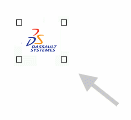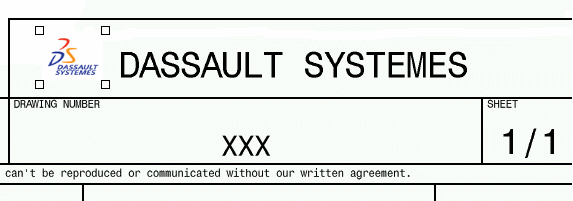- Define a new sheet and a view.
- Insert a frame and title block (choose the Drawing_Titleblock_Samples1).
- Save the logo.tif document on your computer (to do this, right-click on "logo.tif" and choose Save Target As in the contextual menu).
-
Select Insert > Picture.
A dialog box appears, allowing you to browse your disk.
-
Select the file "logo.tif" you have previously imported. The image is imported in your drawing.
-
Click on the image to select it. Scaling manipulators appear. Drag one of the manipulators to decrease the picture size.

You get this:


The image is a native V5 Drafting element, it is positioned by default at the origin of the view.
The anchor point of the picture corresponds to its lower left-hand corner.
- In the Properties dialog box available from the image's contextual menu, on the Picture tab, check the Lock aspect ratio option to make sure images will keep their ratio aspect.
- If the previous option is unchecked, use the Ctrl key to keep the picture ratio aspect.
- Use the Shift key to snap to the grid.
-
Drag the image to the required position.


It is impossible to rotate an image by using standard Rotation. However, if either a ditto or a view containing a monochrome raster image is rotated then the image representation will also be
rotated. Note that raster polychrome and vector images do not follow this behavior so that they can not be rotated in any case.
![]()